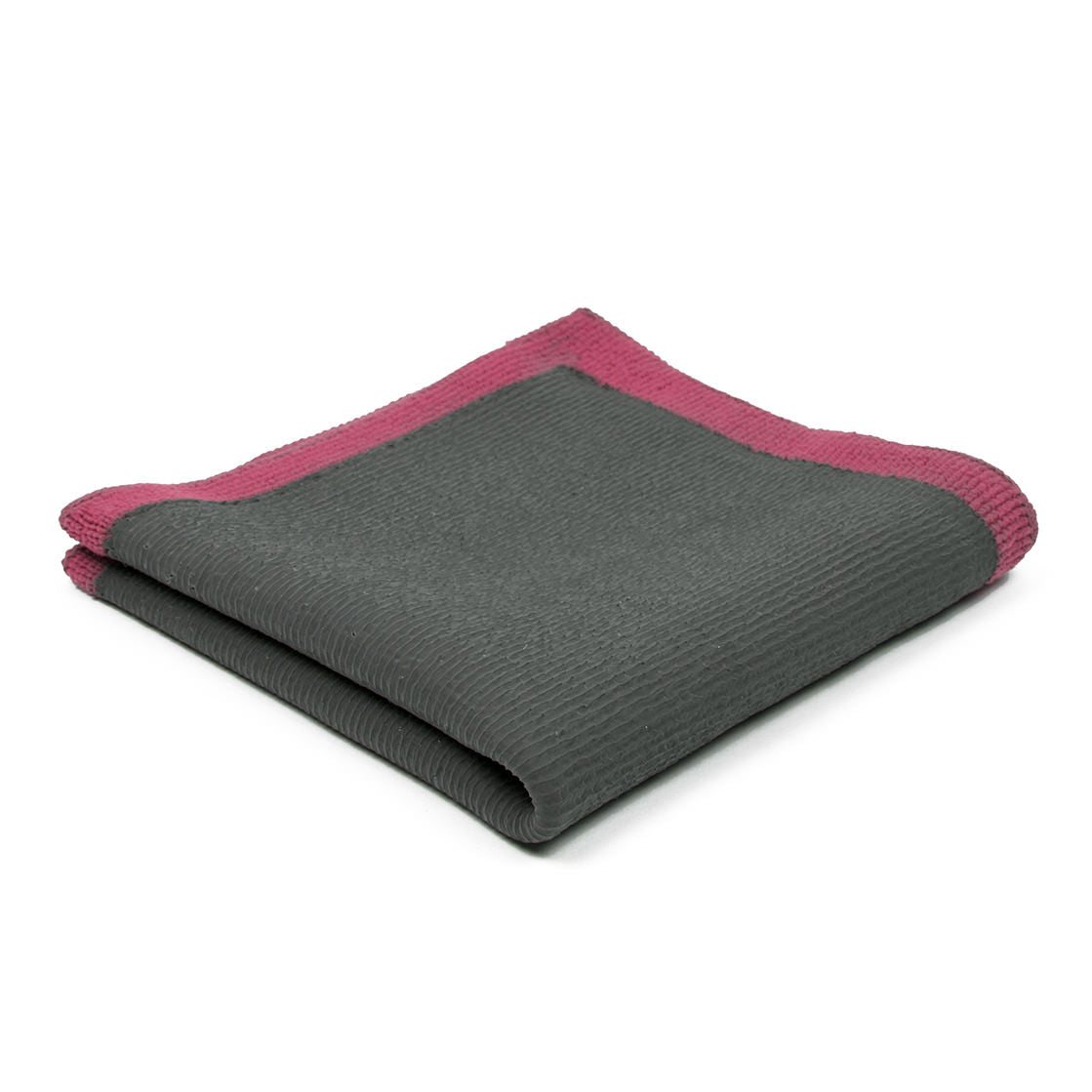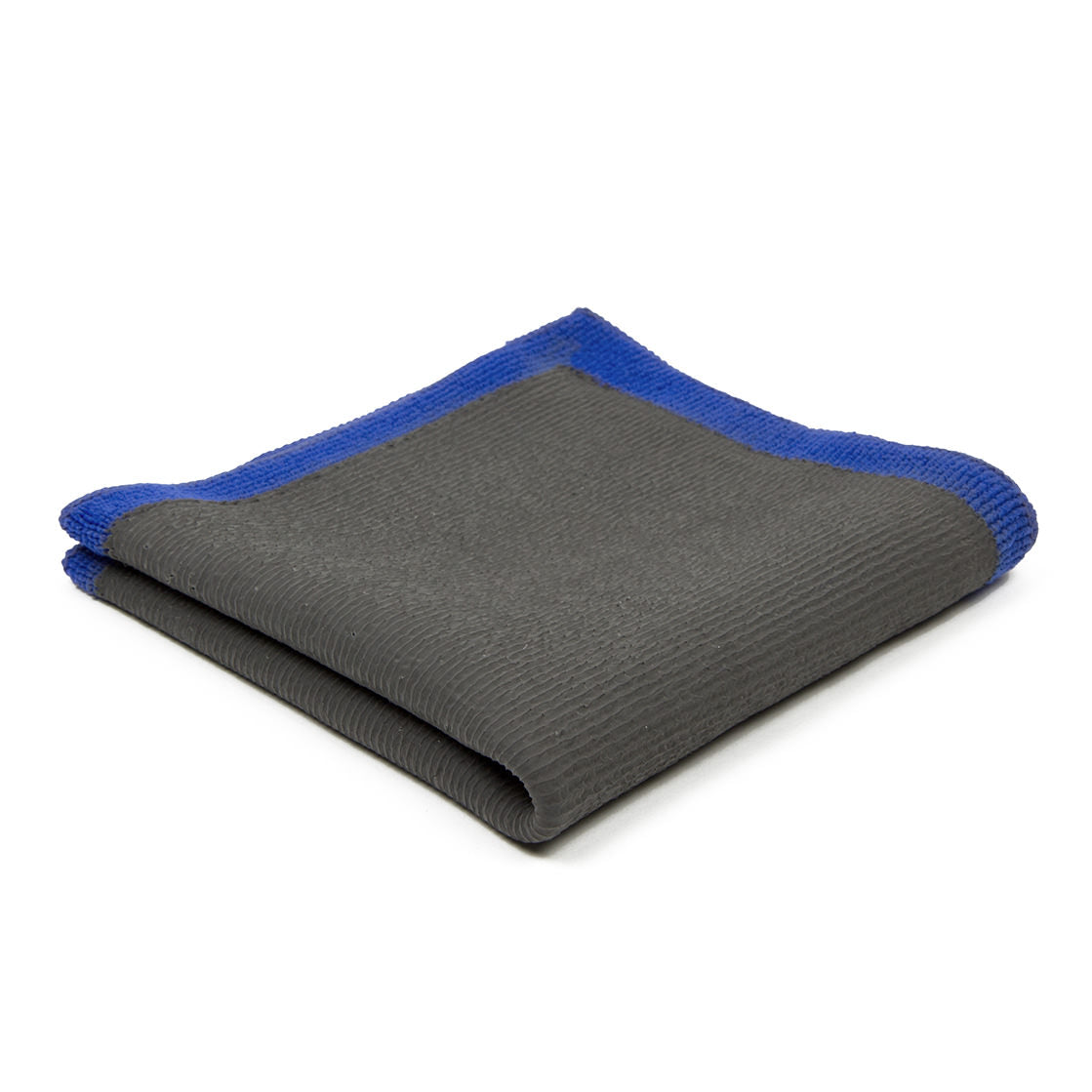
We Say
Clay towels offer a number of advantages when it comes to removing bonded contaminants from exterior automotive surfaces. While the use of both tar and iron removers undoubtedly makes the decontamination process quicker and safer, the use of a clay bar is still required in many cases to ensure complete contaminant removal. And detailing clay, as we all know, isn't the easiest thing to use. In particular, it needs to be warmed up before use to make it soft and pliable (if it's cold and stiff it will feel grabby and inflict marring). Also, it has to be thrown out if you accidentally drop it (because dirt to sticks to it and can't easily be washed off). Furthermore, using clay bars can also be relatively expensive if you do a lot of detailing, as there is a limit to the amount of contamination they can absorb before they have to be replaced.
The Atomiza Clay Towel is designed to replace the clay bar in the decontamination process. By using a special kind of polymerised rubber (bonded to a microfibre towel), it is able to dislodge bonded contaminants when rubbed over exterior automotive surfaces, and thus mimic the result that a clay bar produces, i.e. perfect smoothness. Furthermore, it does this without needing to be warmed up first (or kept warm during use), and it can be rinsed completely clean with running water, meaning that it not only has a far greater life expectancy than a clay bar (up to five times as long), but also does not have to be thrown out if you accidentally drop it. However, perhaps the biggest benefit the Atomiza Clay Towel offers is a significant time-saving; on a like for like basis (i.e. mild clay vs. fine towel) it gets the job done much faster.
Are there any downsides to using an Atomiza Clay Towel? The answer is yes; as is often the case in life, gains in one area are sometimes countered by losses in another. While it is easier to use and works much faster than a clay bar, the Atomiza Clay Towel does tend to leave a little more marring behind if your technique isn't spot on. With a little practice this almost becomes a moot point in the case of the fine grade towel, but it's important to bear in mind to start with, because after your first few attempts you may need to do some corrective polishing. And please note, the medium grade towel is extremely abrasive (more so than many aggressive clay bars); it works brilliantly but does tend to inflict a significant amount of marring, even if your technique is good, so should only be used when a subsequent machine polishing step is planned.
The Atomiza Clay Towel is designed to replace the clay bar in the decontamination process. By using a special kind of polymerised rubber (bonded to a microfibre towel), it is able to dislodge bonded contaminants when rubbed over exterior automotive surfaces, and thus mimic the result that a clay bar produces, i.e. perfect smoothness. Furthermore, it does this without needing to be warmed up first (or kept warm during use), and it can be rinsed completely clean with running water, meaning that it not only has a far greater life expectancy than a clay bar (up to five times as long), but also does not have to be thrown out if you accidentally drop it. However, perhaps the biggest benefit the Atomiza Clay Towel offers is a significant time-saving; on a like for like basis (i.e. mild clay vs. fine towel) it gets the job done much faster.
Are there any downsides to using an Atomiza Clay Towel? The answer is yes; as is often the case in life, gains in one area are sometimes countered by losses in another. While it is easier to use and works much faster than a clay bar, the Atomiza Clay Towel does tend to leave a little more marring behind if your technique isn't spot on. With a little practice this almost becomes a moot point in the case of the fine grade towel, but it's important to bear in mind to start with, because after your first few attempts you may need to do some corrective polishing. And please note, the medium grade towel is extremely abrasive (more so than many aggressive clay bars); it works brilliantly but does tend to inflict a significant amount of marring, even if your technique is good, so should only be used when a subsequent machine polishing step is planned.
Key Features
Abrasive StrengthFrom 6/10(Compared To Others)
Net Weight105 g(Without Packaging)
Removes ContaminantsYes(All Types)
Description
The Atomiza Clay Towel is designed to replace a traditional clay bar in the decontamination process, and offers significant advantages in terms of efficiency and value for money. The Atomiza Clay Towel comprises a thin layer of polymerised rubber bonded to a closed-loop microfibre towel. Two different versions of the rubber are used to produce two different grades of the towel; medium and fine. The Atomiza Clay Towel works in a slightly different way to a traditional clay bar; instead of relying on abrasive particles to gradually abrade away bonded contaminants, the Atomiza Clay Towel uses its polymerised rubber surface to grab and shear off such contaminants. As a result, it cleans the surface much faster than a clay bar.
The Atomiza Clay Towel quickly, easily and safely removes industrial fallout, brake dust, railway dust, paint overspray and other contaminants from bodywork and glass. Like a traditional clay bar, it must be used in conjunction with a suitable lubricant, otherwise it simply will not work (rubber does not slide over other surfaces easily unless it's well lubricated). Although it's possible to achieve this using water alone, it's much safer to use a slippery oil-rich lubricant, as this reduces the risk of inflicting surface marring during the process. Unlike a clay bar, the Atomiza Clay Towel doesn't absorb the contaminants it removes, meaning it can be rinsed clean with running water and then safely used again (this also applies if it is dropped).
While the Atomiza Clay Towel is suitable for use by both car care enthusiasts and professional detailers, the latter will find its efficiency and long-term value hard to resist. The Atomiza Clay Towel not only saves valuable time in cases where contamination levels are severe, but it also has a far greater life expectancy than a clay bar (up to five times as long). Thus, over the course of a typical financial year, the initially greater upfront cost of buying a pair of Atomiza Clay Towels (which will typically last for at least the full year) is easily offset by the savings made as a result of not having to repeatedly buy clay bars. Such savings offer a way of increasing profitability without having to raise prices, which is always good for business.
The Atomiza Clay Towel quickly, easily and safely removes industrial fallout, brake dust, railway dust, paint overspray and other contaminants from bodywork and glass. Like a traditional clay bar, it must be used in conjunction with a suitable lubricant, otherwise it simply will not work (rubber does not slide over other surfaces easily unless it's well lubricated). Although it's possible to achieve this using water alone, it's much safer to use a slippery oil-rich lubricant, as this reduces the risk of inflicting surface marring during the process. Unlike a clay bar, the Atomiza Clay Towel doesn't absorb the contaminants it removes, meaning it can be rinsed clean with running water and then safely used again (this also applies if it is dropped).
While the Atomiza Clay Towel is suitable for use by both car care enthusiasts and professional detailers, the latter will find its efficiency and long-term value hard to resist. The Atomiza Clay Towel not only saves valuable time in cases where contamination levels are severe, but it also has a far greater life expectancy than a clay bar (up to five times as long). Thus, over the course of a typical financial year, the initially greater upfront cost of buying a pair of Atomiza Clay Towels (which will typically last for at least the full year) is easily offset by the savings made as a result of not having to repeatedly buy clay bars. Such savings offer a way of increasing profitability without having to raise prices, which is always good for business.
Specification
| Construction | Polymerised rubber and microfibre |
|---|---|
| Net Weight | 105 g |
| Removes Inorganic Contaminants | Yes |
| Removes Organic Contaminants | Yes |
| Strips Coatings | No |
| Strips Sealants And Waxes | Yes (partially) |
How To Use
The Atomiza Clay Towel should be used out of direct sunlight, on freshly washed bodywork and glass that is cool to the touch. For best results, wash and rinse your car as usual and then, working on one panel or window at a time, spray both the surface to be treated and the polymerised rubber face of the towel with a suitable lubricant (we recommend using Auto Finesse Glide, although other clay bar lubricants may also be used). Next, fold the towel in half and then half again (with the rubber side out), then lay it on the panel and, using light pressure, begin rubbing it gently in straight lines in all directions. Initially you will feel some resistance (as the towel encounters bonded contaminants), but gradually this will ease until the towel glides freely, indicating that the contaminants have been fully removed and perfect smoothness restored. Repeat these steps until all of the bodywork and glass is done, and then rinse the whole car thoroughly and dry it off.
Care instructions: (i) rinse thoroughly with running water after each use (there is no need to use any soap or detergent); (ii) allow to dry naturally on a line or tumble dry on a cool heat setting (avoid radiators and other sources of high heat), and; (iii) store in a dry, dust-free environment while not in use (lidded plastic storage boxes are ideal in this respect).
Care instructions: (i) rinse thoroughly with running water after each use (there is no need to use any soap or detergent); (ii) allow to dry naturally on a line or tumble dry on a cool heat setting (avoid radiators and other sources of high heat), and; (iii) store in a dry, dust-free environment while not in use (lidded plastic storage boxes are ideal in this respect).


